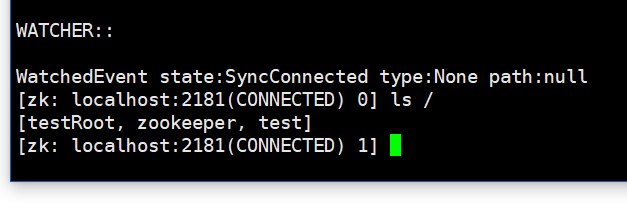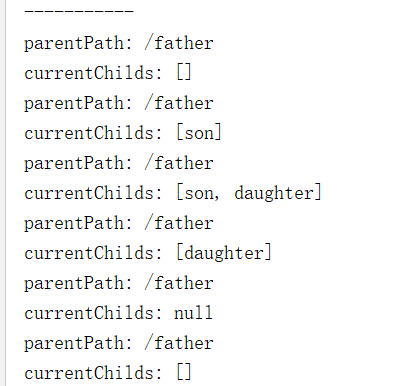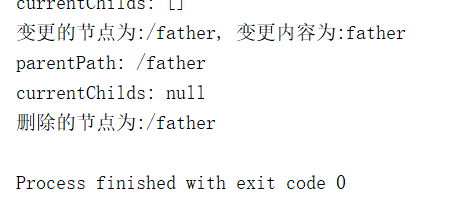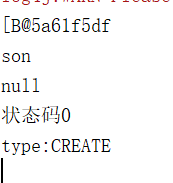打开zookeeper集群

先体会一下原生API有多麻烦(可略过):
//地址
static final String ADDR = "192.168.171.128:2181,192.168.171.129:2181,192.168.171.130:2181";
//session超时时间
static final int SESSION_OUTTIME = 2000;//ms
/**
* 信号量,阻塞程序执行,用于等待zookeeper连接(异步的)成功,发送成功信号
*/
static final CountDownLatch connectedSemaphore = new CountDownLatch(1);
public static void main(String[] args) throws Exception {
//创建zk客户端(异步连接) Watcher:监听连接
ZooKeeper zooKeeper = new ZooKeeper(ADDR, SESSION_OUTTIME, new Watcher() {
@Override
public void process(WatchedEvent watchedEvent) {
//获取事件的状态
Event.KeeperState keeperState = watchedEvent.getState();
Event.EventType eventType = watchedEvent.getType();
//如果是建立连接
if(Event.KeeperState.SyncConnected == keeperState){
if(Event.EventType.None == eventType){
//如果建立连接成功,则发送信号量,让后续阻塞程序向下执行
connectedSemaphore.countDown();
System.out.println("zk 建立连接");
}
}
}
});
//进行阻塞,等待zk连接成功
connectedSemaphore.await();
//连接成功执行操作:
//同步 路径(不允许递归创建), 数据 权限, 类型(PERSISTENT:持久) :临时节点只是一次session有效,用来实现分布式锁
String name = zooKeeper.create("/testRoot", "test".getBytes(), ZooDefs.Ids.OPEN_ACL_UNSAFE, CreateMode.PERSISTENT);
String name1 = zooKeeper.create("/testRoot/child02", "test".getBytes(), ZooDefs.Ids.OPEN_ACL_UNSAFE, CreateMode.PERSISTENT);
//异步 回调函数 , 回调的参数
zooKeeper.create("/testRoot/child01", "test".getBytes(), ZooDefs.Ids.OPEN_ACL_UNSAFE, CreateMode.PERSISTENT,
new AsyncCallback.StringCallback() {
@Override //服务端响应吗: 0 成功 传入的path 参数 实际创建的path
public void processResult(int i, String s, Object o, String s1) {
System.out.println(i+" "+s+" "+o.toString()+" "+s1); }},"param");
//删除 (路径必须是叶子节点,即没有下一级节点,不支持递归)
//zooKeeper.delete("/testRoot/child01", -1);//版本号:-1表示删除所有的,像git一样,修改一次版本号加一,可删除指定版本号
//同样支持异步,和创建一样传入回调
//判断节点是否存在
System.out.println(zooKeeper.exists("/testRoot/child01", false));//也可传入watch,异步回调等
//获取
byte[] data = zooKeeper.getData("/testRoot", false, null);
System.out.println(new String(data));
System.out.println(zooKeeper.getChildren("/testRoot", false));
//修改
zooKeeper.setData("/testRoot", "modify data root".getBytes(), -1);
byte[] data1 = zooKeeper.getData("/testRoot", false, null);
System.out.println(new String(data1));
Thread.sleep(3000);//休眠防止异步
zooKeeper.close();//释放资源
zkclient:
/** zookeeper地址 */
static final String CONNECT_ADDR = "192.168.171.128:2181,192.168.171.129:2181,192.168.171.130:2181";
/** session超时时间 */
static final int SESSION_OUTTIME = 5000;//ms
public static void main(String[] args) {
// 创建zkclient实例
ZkClient zkc=new ZkClient(new ZkConnection(CONNECT_ADDR,SESSION_OUTTIME),10000);
//增
zkc.create("/test","测试zkclient",CreateMode.PERSISTENT);// 创建节点,可指定持久或者临时
zkc.create("/test/heyi","heyi",CreateMode.PERSISTENT);// 创建节点,可指定持久或者临时
zkc.createEphemeral("/haha","haha");//创建临时节点
zkc.createPersistent("/test/yaozhen","姚振");//创建持久节点,设置值必须有父节点
zkc.createPersistent("/320/houzheng",true);//支持递归创建,但是不能设置值,否则会报异常
//删
zkc.delete("/test/yaozhen");
zkc.deleteRecursive("/320");//递归删除,会删除节点下的子节点
//改
zkc.writeData("/test","新内容");
//查
boolean exists = zkc.exists("/test");
System.out.println(exists);
zkc.readData("/jim",true);//如果节点为空返回null
String readData = zkc.readData("/test");
System.out.println(readData);
//获取子节点和阅读子节点数据
List<String> list = zkc.getChildren("/test");
for(String p : list){
System.out.println(p);
String rp = "/test/" + p;
String data = zkc.readData(rp);
System.out.println("节点为:" + rp + ",内容为: " + data);
}
int i = zkc.countChildren("/test");//查询子节点数量
System.out.println(i);
相比之下zkclient简直太简单了!
watcher也特别简单:
子节点监听:
// 创建zkclient实例
ZkClient zkClient=new ZkClient(new ZkConnection(CONNECT_ADDR,SESSION_OUTTIME),10000);
System.out.println("-----------");
//监听子节点变化(不监听数据变化,只监听节点的新增删除) IZkChildListener实现类
zkClient.subscribeChildChanges("/father",(x,y)->{//x:父路径, y:所有子节点路径集合
System.out.println("parentPath: " + x);
System.out.println("currentChilds: " + y);
});
Thread.sleep(2000);
zkClient.createPersistent("/father");//父节点添加删除也会监听
Thread.sleep(1000);
zkClient.createPersistent("/father/son","儿子");
Thread.sleep(1000);
zkClient.createPersistent("/father/daughter","女儿");
Thread.sleep(1000);
zkClient.delete("/father/son");
Thread.sleep(1000);
zkClient.deleteRecursive("/father");

节点数据监听:
//监听节点数据变化,监听之前节点必须存在,不监听子节点
zkClient.createPersistent("/father", "1234");
zkClient.subscribeDataChanges("/father", new IZkDataListener() {
@Override //节点数据变化
public void handleDataChange(String s, Object o) throws Exception {
System.out.println("变更的节点为:" + s + ", 变更内容为:" + o);
}
@Override //节点删除
public void handleDataDeleted(String s) throws Exception {
System.out.println("删除的节点为:" + s);
}
});
Thread.sleep(3000);
zkClient.writeData("/father", "father");//-1:最新版本的数据
Thread.sleep(1000);
zkClient.delete("/father");//节点删除野人不监听
Thread.sleep(1000);

状态监听:
//监听服务连接状态,可手动启动关闭zookeeper查看触发
zkClient.subscribeStateChanges(new IZkStateListener() {
@Override
public void handleStateChanged(Watcher.Event.KeeperState state) throws Exception {
if(state==Watcher.Event.KeeperState.SyncConnected){
System.out.println("连接zookeeper成功");
}else if(state==Watcher.Event.KeeperState.Disconnected){
System.out.println("zookeeper断开");
}else
System.out.println("other"+state);
}
@Override //连接关闭,过了session的设置时间,再连接session就会重置,触发监听
public void handleNewSession() throws Exception {
System.out.println("newsession");
}
});
Thread.sleep(Integer.MAX_VALUE);//用不关闭线程,一直监听
curator框架:
基本增删改查:
//重试策略:初试时间为1s 重试10次
RetryPolicy retryPolicy = new ExponentialBackoffRetry(1000, 10);
//通过工厂建立连接
CuratorFramework curatorFramework = CuratorFrameworkFactory.builder().connectString(CONNECT_ADDR) //连接地址
.sessionTimeoutMs(SESSION_OUTTIME)
.retryPolicy(retryPolicy)//重试策略
.build();
curatorFramework.start();//一定要开启连接
//增 creatingParentsIfNeeded:同时创建父节点 withMode:指定节点类型(不加withMode默认为持久类型节点)
curatorFramework.create().creatingParentsIfNeeded().withMode(CreateMode.PERSISTENT)
.forPath("/super/son","儿子".getBytes());//路径、数据内容
curatorFramework.create().creatingParentsIfNeeded().withMode(CreateMode.PERSISTENT)
.forPath("/father/son","儿子".getBytes());//路径、数据内容
//删
curatorFramework.delete().deletingChildrenIfNeeded().forPath("/super");//递归删除子节点
//改
curatorFramework.setData().forPath("/father/son","新儿子".getBytes());
//查
byte[] bytes = curatorFramework.getData().forPath("/father/son");
System.out.println(bytes.toString());
//查找子节点
curatorFramework.getChildren().forPath("/father").forEach(x-> System.out.println(x));
//判断节点是否存在
Stat stat = curatorFramework.checkExists().forPath("/super");
System.out.println(stat);//不存在,返回bull
//使用inBackground 绑定回调函数
ExecutorService pool = Executors.newCachedThreadPool();
curatorFramework.create().creatingParentsIfNeeded().withMode(CreateMode.PERSISTENT)
.inBackground((cf,curatorEvent)->{//BackgroundCallback实现类
System.out.println("状态码"+curatorEvent.getResultCode());//0表示成功
System.out.println("type:"+curatorEvent.getType());//CREATE
},pool).forPath("/320/yaozhen","姚振".getBytes());
//使用线程池做回调
Thread.sleep(Integer.MAX_VALUE);//等待,方便查看打印输出

监听:
//重试策略:初试时间为1s 重试10次
RetryPolicy retryPolicy = new ExponentialBackoffRetry(1000, 10);
//通过工厂建立连接
CuratorFramework curatorFramework = CuratorFrameworkFactory.builder().connectString(CONNECT_ADDR) //连接地址
.sessionTimeoutMs(SESSION_OUTTIME)
.retryPolicy(retryPolicy)//重试策略
.build();
curatorFramework.start();
//建立一个cache缓存,监听节点
final NodeCache nodeCache = new NodeCache(curatorFramework,"/father");
nodeCache.start(true);//第一次启动的时候就会立刻在Zookeeper上读取对应节点的数据内容,并保存在Cache中
//触发事件为创建节点和更新节点,在删除节点的时候并不触发此操作
nodeCache.getListenable().addListener(()->{ //NodeCacheListener实现类
System.out.println("路径为:" + nodeCache.getCurrentData().getPath());
System.out.println("数据为:" + new String(nodeCache.getCurrentData().getData()));
System.out.println("状态为:" + nodeCache.getCurrentData().getStat());
System.out.println("---------------------------------------");
});
Thread.sleep(1000);
curatorFramework.create().forPath("/father", "123".getBytes());
Thread.sleep(1000);
curatorFramework.setData().forPath("/father", "456".getBytes());
Thread.sleep(1000);
curatorFramework.delete().forPath("/father");
Thread.sleep(Integer.MAX_VALUE);
监听节点
//重试策略:初试时间为1s 重试10次
RetryPolicy retryPolicy = new ExponentialBackoffRetry(1000, 10);
//通过工厂建立连接
CuratorFramework curatorFramework = CuratorFrameworkFactory.builder().connectString(CONNECT_ADDR) //连接地址
.sessionTimeoutMs(SESSION_OUTTIME)
.retryPolicy(retryPolicy)//重试策略
.build();
curatorFramework.start();
//监听子节点:建立一个PathChildrenCache缓存,第三个参数为是否接受节点数据内容 如果为false则不接受
PathChildrenCache cache = new PathChildrenCache(curatorFramework, "/father", true);
//在初始化的时候就进行缓存监听
cache.start(PathChildrenCache.StartMode.POST_INITIALIZED_EVENT);
//监听子节点的新增,修改,删除
cache.getListenable().addListener((cf,event)-> {//PathChildrenCacheListener实现类
switch (event.getType()) {
case CHILD_ADDED:
System.out.println("添加子节点 :" + event.getData().getPath());
break;
case CHILD_UPDATED:
System.out.println("更新子节点 :" + event.getData().getPath());
break;
case CHILD_REMOVED:
System.out.println("删除子节点 :" + event.getData().getPath());
break;
default:
break;
}
});
//创建本身节点不发生变化
curatorFramework.create().forPath("/father", "init".getBytes());
//添加子节点
Thread.sleep(1000);
curatorFramework.create().forPath("/father/c1", "c1内容".getBytes());
Thread.sleep(1000);
curatorFramework.create().forPath("/father/c2", "c2内容".getBytes());
//修改子节点
Thread.sleep(1000);
curatorFramework.setData().forPath("/father/c1", "c1更新内容".getBytes());
//删除子节点
Thread.sleep(1000);
curatorFramework.delete().forPath("/father/c2");
//删除本身节点
Thread.sleep(1000);
curatorFramework.delete().deletingChildrenIfNeeded().forPath("/father");
Thread.sleep(Integer.MAX_VALUE);
监听子节点
分布式锁:
//重试策略:初试时间为1s 重试10次
RetryPolicy retryPolicy = new ExponentialBackoffRetry(1000, 10);
//通过工厂建立连接
CuratorFramework curatorFramework = CuratorFrameworkFactory.builder().connectString(CONNECT_ADDR) //连接地址
.sessionTimeoutMs(SESSION_OUTTIME)
.retryPolicy(retryPolicy)//重试策略
.build();
curatorFramework.start();
//使用分布式锁,所有系统同时监听同一个节点,达到分布式锁的目的
final InterProcessMutex lock = new InterProcessMutex(curatorFramework, "/test");
final CountDownLatch countDownLatch = new CountDownLatch(1);
for (int i = 0; i < 10; i++) {
new Thread(()->{
try {
countDownLatch.await();//线程等待一起执行
lock.acquire();//分布式锁,数据同步
//处理业务
j--;
System.out.println(j);
} catch (Exception e) {
e.printStackTrace();
} finally {
try {//释放锁
lock.release();
} catch (Exception e) {
e.printStackTrace();
}
}
},"t"+i).start();
}
Thread.sleep(1000);
countDownLatch.countDown();//模拟十个线程一起并发.指定一起执行
}
static int j=10;
这里模拟了一下十个线程并发,其实和ReentrantLock效果一样的,但是在分布式中也可以实现同步,而ReentrantLock就不行了
分布式计数器:
和分布式锁其实都是同理:
/** zookeeper地址 */
static final String CONNECT_ADDR = "192.168.171.128:2181,192.168.171.129:2181,192.168.171.130:2181";
/** session超时时间 */
static final int SESSION_OUTTIME = 5000;//ms
public static void main(String[] args) throws Exception {
//重试策略:初试时间为1s 重试10次
RetryPolicy retryPolicy = new ExponentialBackoffRetry(1000, 10);
//通过工厂建立连接
CuratorFramework curatorFramework = CuratorFrameworkFactory.builder().connectString(CONNECT_ADDR) //连接地址
.sessionTimeoutMs(SESSION_OUTTIME)
.retryPolicy(retryPolicy)//重试策略
.build();
curatorFramework.start();
//分布式计数器
DistributedAtomicInteger counter=new DistributedAtomicInteger(curatorFramework,"/super",new RetryNTimes(3,100));
//初始化
counter.forceSet(0);
AtomicValue<Integer> value = counter.increment();//原子自增
System.out.println("原值为"+value.preValue());
System.out.println("更改后的值为"+value.postValue());
System.out.println("状态"+value.succeeded());
}
分布式线程屏障同步:
for (int i = 0; i < 5; i++) {//模拟5个客户端
new Thread(()->{
try {
RetryPolicy retryPolicy = new ExponentialBackoffRetry(1000, 10);
CuratorFramework cf = CuratorFrameworkFactory.builder()
.connectString(CONNECT_ADDR)
.retryPolicy(retryPolicy)
.build();
cf.start();
//双重同步DistributedDoubleBarrier: 指定5个线程,到了5个会自动触发
DistributedDoubleBarrier barrier = new DistributedDoubleBarrier(cf, "/super", 5);
Thread.sleep(1000 * (new Random()).nextInt(3));
System.out.println(Thread.currentThread().getName() + "已经准备");
barrier.enter();//准备,等待成员到达5个再一起往下执行
System.out.println("同时开始运行...");
Thread.sleep(1000 * (new Random()).nextInt(3));
System.out.println(Thread.currentThread().getName() + "运行完毕");
barrier.leave();//再次等待准备退出,5个都是leave状态时再一起退出
System.out.println("同时退出运行...");
} catch (Exception e) {
e.printStackTrace();
}
},"t" + i).start();
}
和java中CyicrBarrier一模一样,只是支持分布式
static DistributedBarrier barrier;
public static void main(String[] args) throws Exception {
for(int i = 0; i < 5; i++){
new Thread(()-> {
try {
RetryPolicy retryPolicy = new ExponentialBackoffRetry(1000, 10);
CuratorFramework cf = CuratorFrameworkFactory.builder()
.connectString(CONNECT_ADDR)
.sessionTimeoutMs(SESSION_OUTTIME)
.retryPolicy(retryPolicy)
.build();
cf.start();
barrier = new DistributedBarrier(cf, "/test");
System.out.println(Thread.currentThread().getName() + "设置barrier!");
barrier.setBarrier();//设置
barrier.waitOnBarrier(); //等待Barrier释放,准备一起执行
System.out.println("---------开始执行程序----------");
} catch (Exception e) {
e.printStackTrace();
}
},"t" + i).start();
}
Thread.sleep(10000);
if(barrier != null){
System.out.println("启动所有线程");
barrier.removeBarrier();//删除屏障
}
}
最后一个是只实现同时执行的,很奇怪,实际练习中开始执行程序这就是不执行,线程也一直卡在折了,启动这块都打印了!还得再研究下!